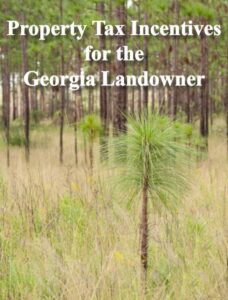 Keeping up with changes in Georgia’s property tax laws is a full-time job, and a new book shows the fruits of these efforts.
Keeping up with changes in Georgia’s property tax laws is a full-time job, and a new book shows the fruits of these efforts.
“Property Tax Incentives for the Georgia Landowner” is an annual guide published by the Harley Langdale Jr. Center for Forest Business at the University of Georgia. This year’s edition is now available for download—as well as a limited supply of hard copies—and gives clear guidance to property owners who own land used for agricultural and timber production, as well as some transitional residential properties.
“Every year we update the electronic version, but this time we’re not only updating the electronic version, but also the print version,” says Yanshu Li, assistant professor of forest economics and taxation at UGA’s Warnell School of Forestry and Natural Resources. “This year there are some major changes in the legislation, so we updated the print version.”
The 192-page book reviews all the ad valorem tax incentives offered to owners of land classified as agricultural or protected by a conservation covenant. The guide also includes tables of timber tax calculations and payments, explanations and guidance for the Forest Land Protection Act and the new Qualified Timber Property tax class.
Property taxes are one of the top concerns of private forest landowners in Georgia, said Li, citing findings of the 2013 USDA Forest Service National Woodland Owner Survey. While property taxes are an annual expense, income from timber sales happen only occasionally over an owner’s lifetime. “The stress becomes more acute for landowners whose lands are on the rural-urban fringe,” she added. “It’s important for agricultural and forest landowners to understand property tax incentives available to them and help them keep their lands in conservation uses, including agricultural and forestry uses.”
A constitutional amendment approved by voters in 2018 created a new class of qualified timber property, said Bob Izlar, director of the Center for Forest Business, and this change was another reason for publishing the book in both print and electronic versions. The amendment moves assessment of certain timberland to the state Department of Revenue and offers a unique benefit to taxpayers that might not be ready to a longer-term commitment of an agricultural covenant.
The book also contains the details of a major change to the Forest Land Protection Act covenant, which was reduced to 10 years from the previously required 15 years. This brought uniformity of taxation to lands enrolled in the program and forestland under other programs, such as the Conservation Use Valuation Assessment Program, the most popular property tax incentive program in the state, and helped level the playing field.
Other tax revisions detailed in the book include new allowances for agricultural properties with a conservation covenant, such as leasing an area for a cellphone tower or operating a business such as a corn maze or horseback riding.
The book also includes a table of timberland property tax assessment values, which Li reviews for the Department of Revenue as part of her outreach faculty appointment pursuant to O.C.G.A. §48.5.7.4. The book is one of the few places where Georgia property owners can find the table of assessments alongside other valuable, up-to-date property tax explanations and details.
The guide was first published in 1993 and has been updated seven times since its inception. But this is the first printing of the book since its update in 2014. Copies will be distributed to the Georgia Forestry Commission and county Extension offices. The digital version is available for download on the website for the Center for Forest Business: www.ugacfb.com (click on “Research”).


